Consumers are churning through clothing so fast, the clothing collection and resale business can hardly keep up.
By Kathleen Webber
In Eatontown, NJ, not far from the shore, a steady stream of trucks hauls in 33,000 pounds of used clothing a day to the Helpsy warehouse. There it is weighed, sorted, categorized, and recirculated to be sold at thrift stores, vintage shops, or on resale sites where shoppers can get their hands on everything from Everlane jeans to Aritzia dresses to Marc by Marc Jacobs blouses. Companywide, Helpsy, collects 96,000 pounds of clothes a day from thousands of metal bins in 10 states on the East Coast that dot parking lots of malls, churches, schools, and mom-and-pop strip malls.
Consumers provide Helpsy with most of their sales inventory. The change of seasons is the busiest. It is then when consumers, armed with bags of clothes fresh from the closet purge, will toss their once-loved merchandise into a bin ushering it into its new life.
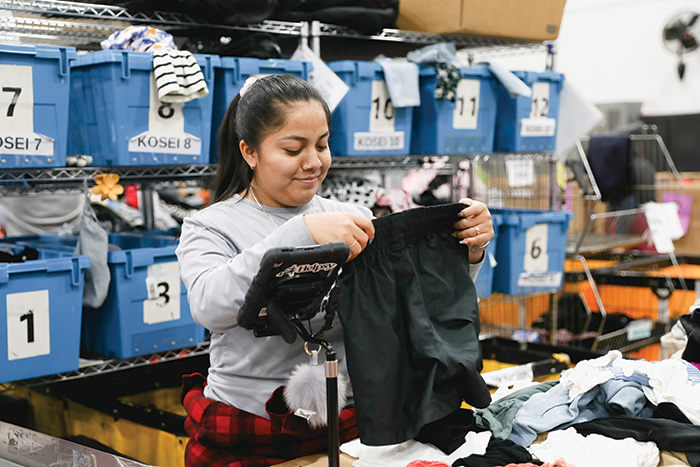
Photos courtesy of Helpsy, Eatontown NJ.
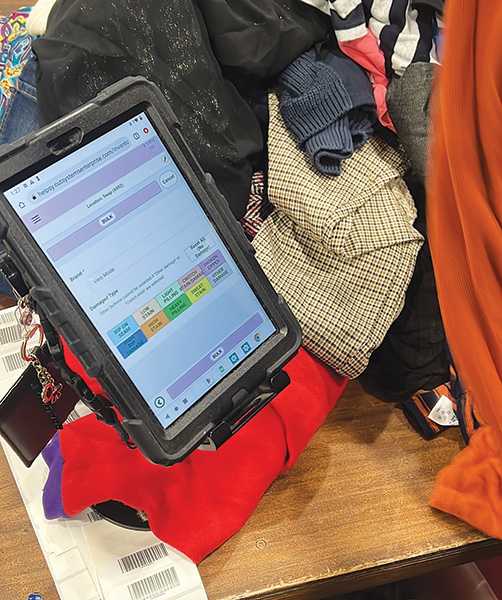
At the Helpsy warehouse, bales of clothing are stacked carefully like Jenga blocks up to the ceiling. Two dozen sorters will use digital scanners to help classify 12,000 items a day, by brand and category, to determine what new sales path the item will go to extend its life and keep it out of landfills.
Helpsy, a for-profit, privately held company, collects 66 pounds of clothing a minute and made $26 million in revenue in 2022 from used clothes and new wholesale clothing they buy from brands and retailers who need help with overstock, e-commerce returns, and styles that may not pass the quality control test like the thousands of Fourth of July swim trunks from Chubbies in a shade of red that did not pass muster with design. All of this clothing and shoes are resold via 6,000 resellers, including stores like Plato’s Closet, Uptown Cheapskates, and Beacon’s Closet, smaller vintage stores or on peer-to-peer selling marketplaces like Poshmark, eBay, Depop, and Mercari.
“We supply online individual resellers with brands to scale up their businesses and thrift stores with brands they can sell,” says Dan Green, co-founder and CEO of Helpsy. “For thrift stores, they either have too much inventory or not the right kind.” Helpsy can help swap out merchandise or fill up shelves with brands that are known sellers for them.
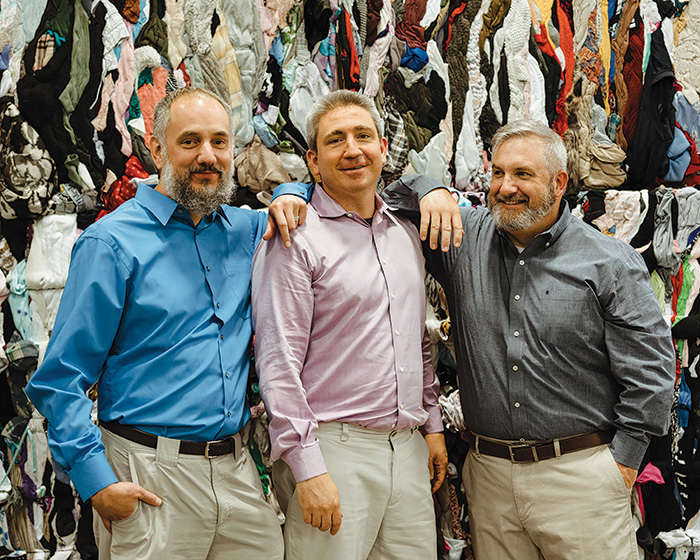
Dan Green, and Dave Milliner.
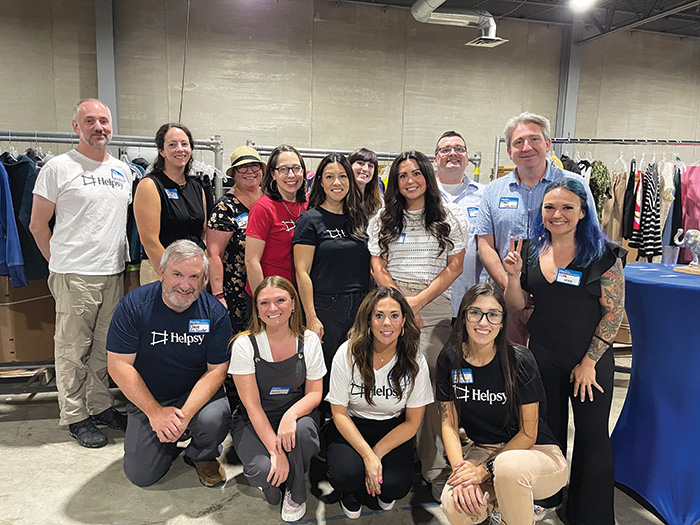
Alex Husted, Gina, Carmen, Nicole, Sandy, Madison, Bridgette,
Victor, Dan, and Lisa. Front left to right, bottom row: Dave Milliner, Devan, Jessica, and Karen
The Changing Market
The recommerce market, reselling previously owned products (including overstocks and retail returns) through physical and online channels, is a sector of retail that is outpacing regular retail. Over the past five years, recommerce revenues have grown 20-plus times faster than overall apparel revenues according to a study by consulting firm Deloitte. One reason this industry is booming: people are buying more clothes than ever and wearing each item less. According to the Ellen MacArthur Foundation, the average piece of clothing is worn 36 percent fewer times now than it was 15 years ago.
Recommerce sales reached $22 billion in 2022 according to a report by Global Data. They estimate that recommerce worldwide will climb to $51 billion in 2023. While wearing secondhand clothing has become mainstream, especially with environmentally-minded Gen Z and Millennial shoppers, the amount of fast fashion being produced annually keeps Helpy’s bins overflowing.
Upstairs at the facility, giant cardboard bins hold sorted, used merchandise from brands like Outdoor Voices, Eileen Fisher, Chico’s, Aritzia, J. Jill, and Banana Republic among others. When one of their stores or resellers calls to ask for a particular brand, they can fill their order.
Since its start in 2016, Helpsy has added warehouses in New York and Massachusetts. In the $3 billion U.S. industry, Helpsy is one of about 100 larger collectors (the industry also has thousands of smaller ones). The big players include non-profits like Goodwill and Salvation Army, which also have brick-and-mortar operations and vertical integration and for-profits like Value Village, says Steve Rees, president of SMART (the Secondary Materials and Recycled Textiles Association). Helpsy is the only B corporation clothing collector. B corps are assessed for social and environmental performance and are re-audited every three years. Helpsy has been certified since 2018.
According to SMART, textile recyclers reuse and recycle 5 billion pounds of textiles each year (this figure includes bed linens and towels). Of the organization’s 150 members, half are domestic companies and half are international. Textiles are the fastest-growing waste stream in landfills. On average, each consumer throws away more than 100 pounds of textiles a year (up from the 1999 figure of 44 pounds a year) and 84 percent ends up in landfills (this figure also includes things like bed linens and towels) or is incinerated. There, it decomposes and releases greenhouse gasses or leaches dyes and other harmful chemicals into the ground and local water supplies.
Working to Transform Waste
Last year, Helpsy kept 35 million pounds out of landfills. They say 95 percent of what is collected is salvageable; 50 percent is sold as clothing and used again as such, while 45 percent becomes things like furniture insulation, or wiping cloths. “Re-using it is the best ecological way to extend the life of a piece of clothing,” says David Milliner, COO at the company. “The more times clothing can be reused, the less virgin material will be used, and that saves water and other resources,” he adds.
The production of clothing makes up 10 percent of global carbon emissions, pollutes rivers and streams with dyes and finishes, and uses fossil fuels in the making of synthetics, which makes up the majority of the clothing we wear. Additionally, up to 35 percent of all microplastics released into the environment can be traced back to textiles.
Up until 2021, Helpsy had outsourced its sorting, but when Covid shut down sorting facilities, the trade of used clothing plummeted, virtually cutting it in half. “If we wanted to expand and make a profit, we needed to sort the clothing ourselves,” says Milliner. So, they brought that function in-house.
Their IT team built the QuickScan sort technology. A sorter enters the brand name into a tablet and then reviews the item for wear and tear and enters that information into the system. A barcode for each item is created assigning it a value and that information gets entered into their data warehouse. A re-seller store will call them and ask for specific brands of clothing or accessory categories. There is an algorithm with an assigned value to a Talbot’s skirt with a broken zipper versus a Banana Republic piece that is in perfect condition.
“Some companies rely on people to decide the value of the clothing,” says Milliner. “What happens when those experts leave the company? We wanted to build technology so that it got it into the best sales channel,” he adds. Last year they sorted and graded 5 million pieces of clothing and shoes by brand and categories (prom dresses or athleisure) to determine the best sales channel for them. Sorters are incentivized to sort as much as they can a day. “Many collectors are working on the process for better sorting,” says Rees. “The process is still not fully automated. Maybe AI down the road will help, but for now, every piece is touched and requires a human to sort.”
To date, Helpsy’s scanning system recognizes 10,000 brands but sorters encounter 200 per day not in the database. They have data that moves through their ecosystem from the bin to the sort to the proper resale channel. “Then we can provide that data back to brands and our customers,” says Jessica Rennard, Chief Merchandising Officer. “Brands can learn things like what types of styles are being donated of theirs and what is selling and use that in their research and development.” They also provide data to the Corporate Social Responsibility teams and the municipalities on how much they are collecting for their reporting.
Helpsy has also started working on extending its sorting technology to encompass fabric type detection and categorization. Green noted, “This is an important step in really being a complete solution for textiles of all types and qualities. Just like recyclers of other materials, we are working to transform waste into useful products as close to the source as possible.” Their team is engaged with a number of partners developing technologies to transform the unwearable clothing that does not have another productive use into new fibers again.
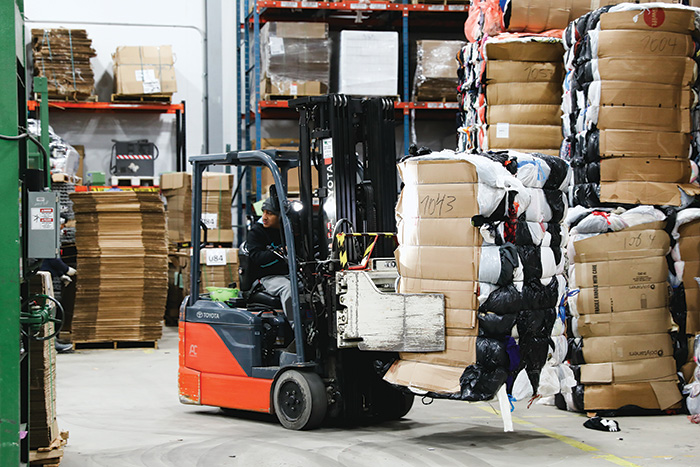
Starting the Business
Founders Dan Green, David Milliner, and Alex Husted, childhood friends from suburban Philadelphia, started Helpsy seven years ago after an ed-tech start-up they had failed in 2000. They went back to their jobs in finance and tech, but bought three clothing collection businesses in New Jersey, New York, and Massachusetts and then added six more to their portfolio. “We wanted to do a triple bottom line business and looked at niches that were ignored,” says Husted, Chief Information Officer. “We stumbled upon this clothing collection business in New Jersey and it served the community and the environment and had unlimited room for growth.”
Husted visits consignment and thrift stores regularly to see what is selling or is not. “The eye candy is the Louis Vuitton bag, or the Dolce and Gabbana sweater, and they make great margins on those kinds of pieces, but lululemon moves faster and brings in cash faster. Some of their best-selling brands for resale are Adidas, Nike, Everlane, The North Face, Zara, and Madewell. They send their higher end/luxury merchandise from their sort to The Real Real on consignment.
Husted says many of their individual re-sellers who buy from them have quit their day jobs to do this full-time. “Many specialize in a category like athletic wear and will only buy and sell that. So instead of them spending time sifting through church sales and Goodwill bins, they come to us for specific brands or categories,” Husted says of this time-saving step. “Re-selling is growing by leaps and bounds, and we see ourselves as selling the picks and shovels to the gold miners. We provide the tools and materials for them to
succeed.”
Controlling the Process
Helpsy Source is a new channel of the company that started 16 months ago where the company sells curated boxes to resellers. The company promotes these bulk boxes on Tiktok, Instagram, IG Live, and Facebook. Rennard oversees all sorted products putting them back into circulation. She works with a growing list of brands and retailers, many of whom hear about the company by word of mouth and who need a plan for what to do with e-commerce and out-of-season returns, overstock, and damages. “We keep their end-of-life product in circulation and out of the landfill and address their concerns as it relates to brand equity; we are able to control the merchandise within our own supply chain to ensure over saturation does not happen.”
Inventory gluts are a headache for brands and retailers. “The warehouse guys say I have 500 pallets of merchandise we need to get rid of. The finance guys say we need the income from those pallets,” Green says. Those pallets will be bought by the small consignment shop owner to a thrift chain to individual sellers looking for a part-time income. Box sizes vary anywhere from 40 items to full pallets which can be close to 600 to 800 units.
Husted says e-commerce returns have become a growing part of the business for them, accounting for about 10 percent of their revenue (90 percent still comes from collected clothing). “When something goes back to the retailer, there is a lot of effort that goes into inspecting it and reshelving it. Consumers buy multiple sizes and send ones that don’t fit back,” he explains. “It is hard for them to re-sell. It takes up space. Returns are now coming directly to us. I can see that business growing.”
When Helpsy works with brands, they will say where they want their clothing sold or not sold. “It is idiosyncratic from brand to brand what they think is a risk to their reputation,” says Green. “Some don’t want their brand in thrift stores, some don’t want their brand on Poshmark or eBay, and others don’t want their product in a market in Ghana if it can’t be sold in the U.S. “
Clothing drives also generate substantial inventory for the company. They will do 400 this year with DARE, AMVETS of NJ, Big Brothers/Sisters, churches, YMCAs, Girl Scouts and hundreds of other nonprofits as well as municipalities who need solutions for their textile waste. “For municipalities, clothes are worth more than plastic and glass and create more greenhouse gas emissions,” Green explains. They would like to work with more in the future.
Working with Cities
In November 2022, Massachusetts banned the dumping of textiles in landfills. With landfills in states across the U.S. filling up, there may be more state textile bans in the future. Helpsy is the sole collector for the city of Boston where they started curbside clothing collection in 2020. They have bins throughout the city and at public schools. The schools are paid by the pound for what they collect. The company shares a monthly report with the city on what they are collecting, says Kristen Shelley, who is in charge of Zero Waste Contracts for Boston Public Works.
The business is not without its challenges. The biggest hurdle is apathy—the sheer inconvenience of donating versus throwing clothing in the trash. “It is a behavioral mindset,” Green explains. The company has begun curbside collection in select cities across the East Coast, most recently in three counties around Philadelphia, PA. They also work with universities and colleges. For instance, Princeton University in New Jersey has collection bins in or near their dorms and does end-of-year cleanouts collecting 40,000 pounds of clothing last year that went straight to Helpsy according to Matt Brinn, of their Office of Sustainability.
Rennard works with mall and athletic wear brand VPs and C-Suite execs to help them navigate their inventory options. “Because we are a B Corp, we are transparent,” says Rennard. “They know what we do with their product. We ensure it doesn’t end up somewhere they don’t want it to end up.” Rennard and her team send out 160 mystery boxes a day of new and used merchandise to resellers. She calls them an important vehicle to circularity. “They (the resellers) push the inventory to the end consumer.” While she is encouraged by the number of people who want to shop at thrift stores and donate clothing, “fast fashion keeps getting faster,” says Rennard.
Rees says there are more players internationally and more recently China has taken an interest in the industry. SMART decided to hold its first international conference in Dubai this past year to share best practices and innovation. Their domestic conference in Houston will explore the use of AI technology in recycling, Rees says. “As long as the population is growing, the business will keep increasing,” says Rees. | WA.
Kathleen Webber is a freelance writer and academic who teaches journalism at The College of New Jersey. She worked in retail and brand product development before writing about the New York fashion industry for many years. Her research and writing focus on sustainability in the global fashion industry, retail innovation and the circular economy. Her bylines have appeared in Women’s Wear Daily, The Philadelphia Inquirer, sustainablebrands.com, Sierra magazine, and ecowatch.com. A version of this story previously ran in The Philadelphia Inquirer on October 12, 2023. Kathleen can be reached at webber@tcnj.edu.
For more information about Helpsy, call (800) 244-6350 or e-mail [email protected].
Resources
www.ellenmacarthurfoundation.org/topics/fashion/overview
https://recommercereport.com
www.bcorporation.net/en-us/certification/
https://helpsysource.com
